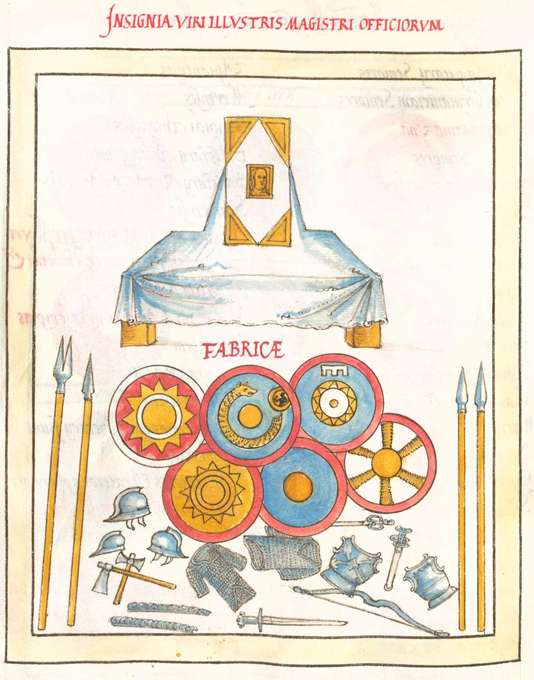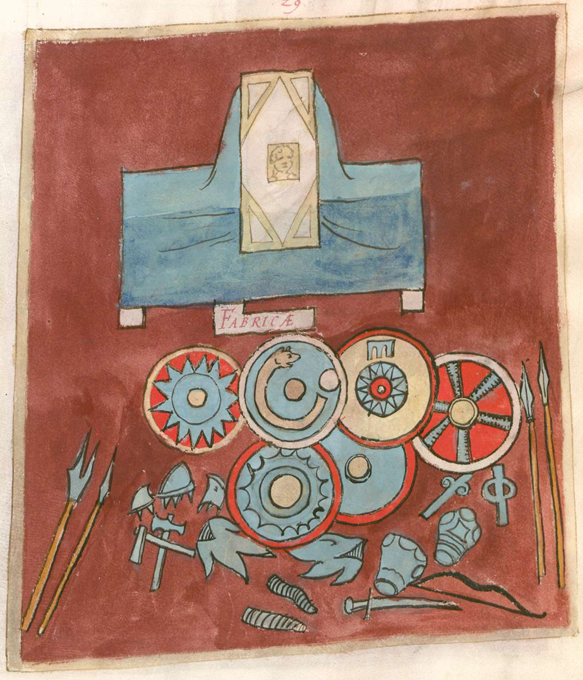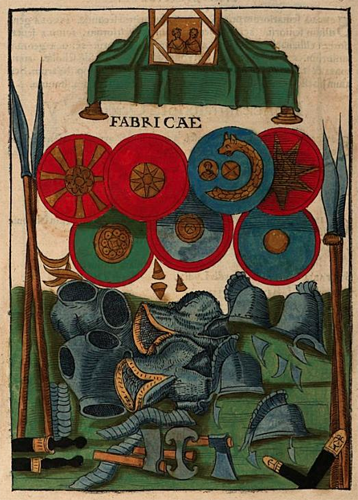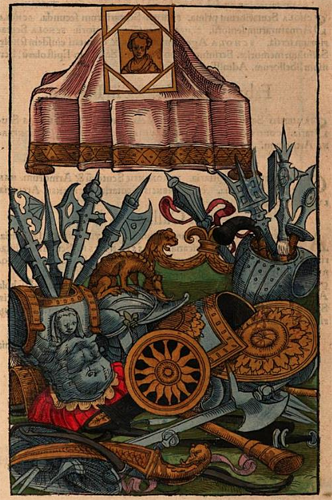
This page last modified: 4 January 2015 (Shield reference numbers added)


|
The following units of military Scholae are listed as being under the command of the Master of Offices in the East (the numbers beside the names refer to Ingo Maier's numbering scheme):
23.2 Schola scutariorum primaShown to the left is the illustration that accompanies the text taken from the Bodleian manuscript (O). The shields are numbered as follows: Top row of three, left to right: 22#3, 22#4, 22#5. Bottom row of three, left to right, sloping upwards: 22#7, 22#8, 22#6.
Disclaimer: Remember, a lot of what comes below is speculation. Hopefully informed speculation, but speculation nonetheless. Comments welcome! (lukeuedasarson "at" gmail.com)
|
It can readily be seen that, unlike the illustrations that accompany the lists of units under normal field commanders, these shield patterns are not labelled with specific unit names. Indeed, it is not certain that these shield patterns are even intended to represent the units under the command of the Master of Offices in the East, since he also has jurisdiction over, amongst other things, various armaments manufacturies called "fabricae". And you can see that the one word (22.b) accompanying the depicted shields (and swords, spears, helmets and other military equipment) is none other than "Fabricae".
Because some 8 fabricae under his command are said to make shields, one might assume the 6 shields shown do not represent the output of these 8 fabricae: a one-to-one correspondence with shields and shield-making establishments would have been nicely symmetrical. And one might further posit that the shields instead represent the military units under his command: the Scholae (there is also one non-military units of scholae under his command - composed of senior servants and their assistants). Unfortunately, the 7 units listed also cannot match the 6 shields shown...
Much ink has been used in trying to tie in the 7 units with these 6 shields. For example, the mismatch has been used to underline the military importance of the Scholae units by supposing the mismatch is caused by frequent reassignments of the units according to military need (J. Barlow and P. Brennan, "Tribuni Scholarum Palatinarum c. A.D. 353-64: Ammianus Marcellinus and the Notitia Dignitatum", Classical Quarterly 51.1 (2001), 237-254); the Scholae of the western Magister Officiorum are similarly mismatched, but in this case, there are only 5 military units listed with 7 shields illustrated. Unfortunately, Barlow and Brennan did not appatrently consider there are in fact 13 units of military Scholae listed in the Notitia, and not 12, because they have not noticed the existence of the Equites scutarii iuniores scholae secundi, under the Comes Africae, which invalidates many of their individual conclusions (if not their overall thesis).
One might for example be tempted to conclude the men of the Schola scutariorum clibanariorum did not carry shields (despite the scutariorum appellation) if clibanarii can be equated to shieldless 'catafractarii'. The other units could then (perhaps) be ascribed the shields from the left to right, top to bottom. However, since another clibanarii unit, the Equites sagittarii clibanarii, listed in the Magister Equitum's cavalry roster, clearly does have a shield pattern, it seems this theory is somewhat strained, to say the least, even if one can accept "scutariorum" doesn't necessarily imply shield... Incidentally, the Schola scutariorum clibanariorum is one of two Scholae units attested in a 389 AD legal reference (Cod.Theod. 14.17.9) as being in existence as early as Constantine I's reign: "scholae scutariorum et scutariorum clibanariorum divi Constantini adseruntur liberalitate meruiss". All in all, the identity of the units, if any, associated with these shields is a mystery (but see my thoughts on my Scholae page).
Below are the corresponding illustrations from the first portion of the Munich manuscript (M, left) and the second portion of the Munich manuscript (W, right).


Below are the corresponding illustrations from the Parisian manuscript (P, left) and the printed Froben edition (B) - for which two pictures are shown (centre, right). The Froben edition appears to have swapped the images for the eastern and western Masters of Offices around, so the centre picture shows what is purportedly the eastern set, but is actual the western set, and the right picture shows what is purportedly the western set, but in this particular case (and only in this case) the image is wildly divergent from those of the other manuscripts.




Return to the Notitia index page.